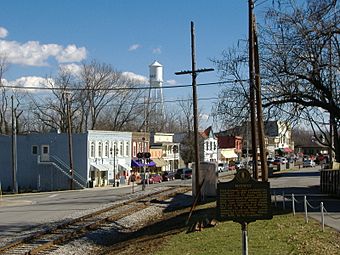Midway Historic District (Midway, Kentucky) facts for kids
Quick facts for kids |
|
|
Midway Historic District
|
|

East side
|
|
| Lua error in Module:Location_map at line 420: attempt to index field 'wikibase' (a nil value). | |
| Location | Midway, Kentucky |
|---|---|
| Architect | Lacefield, R.W.; Et al. |
| Architectural style | Greek Revival, Gothic, Italianate |
| NRHP reference No. | 78001415 |
| Added to NRHP | November 17, 1978 |
The Midway Historic District in Midway, Kentucky, is a special area recognized for its history. It was added to the National Register of Historic Places on November 17, 1978. In 2003, the town worked to make its downtown look better. This was part of the Kentucky Main Street Program.
Contents
Discovering Midway's Past
How Midway Began
Midway was the first town in Kentucky built by a railroad company. The Lexington and Ohio Railroad started it. Their goal was to connect Lexington, Kentucky to the Ohio River. This would let them avoid Louisville.
The railroad began building a line in 1831. It connected Frankfort, Kentucky and Lexington. The first train reached the "midway" point in 1833. This spot was on a farm owned by John Francisco.
In 1835, the railroad bought the farm. They paid $6,491.25 for it. Their engineer, R. C. Hewitt, designed the town. It was named Midway because it was halfway between Frankfort and Lexington. Many streets are named after railroad workers. Kentucky officially made Midway a town in 1846.
The Railroad's Path Today
Even with new technology, the original railroad line is still in use. It runs right through the town's business area. This shows how important the railroad was, and still is, to Midway.
A Moment in History
On July 15, 1862, a famous general named John Hunt Morgan stopped in Midway. He used this stop to trick Union forces. He made them think he was heading to Frankfort. This helped him avoid being caught.
The Famous Porterhouse Steak
The well-known Porterhouse steak got its start in Midway. It was first served at a place called the Porter House. This building is still standing today.
Local Community and Culture
Midway has a museum that is currently in a former saloon. This museum now sells local items. You can find historical books about Kentucky there. The Second Christian Church is also in Midway. It is believed to be the oldest church for African-American people in Kentucky.


